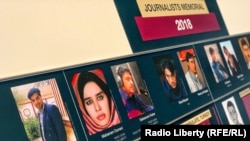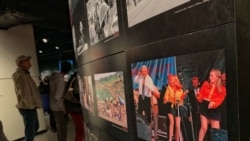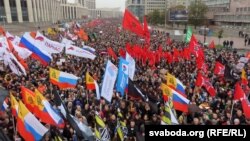
WASHINGTON -- Hundreds of people began arriving outside 550 Pennsylvania Avenue in the U.S. capital shortly after 9 a.m. on a drizzly late December morning.
As they walked toward the line that stretched at times out the door, they glanced at the front pages of U.S. newspapers published on December 30 around the country.
The visitors were hoping to get their last -- or in some cases, their first -- look inside a museum dedicated to the importance of a free press and the First Amendment before it shuts its doors.
It was the museum industry's equivalent of a wake.
Newseum, sandwiched nearly equidistantly between the White House and Capitol Hill, will officially close at the end of business on December 31 amid financial difficulties after an 11-year run.
The closure is symbolic, many have said, of the newspaper industry's own woes.
More than 2,000 newspapers have closed around the United States over the past 15 years as their traditional business model has been disrupted by the Internet and social media.
Companies that once advertised in newspapers have reallocated their spending toward online platforms like Google and Facebook, where people spend more of their time.
Subscription revenues for many papers have also fallen as people seek out free online news sites.
The closure of Newseum also comes at a time when trust in the media is being undermined by the spread of disinformation and criticism from politicians.
U.S. President Donald Trump, a Republican, has repeatedly called the media the "enemy of the people" at his sold-out rallies and on Twitter, where he has 65 million followers.
More than half of Democrats believe the news media try to report the news accurately and without bias whereas that number is below 40 percent for Republicans, according to the 2019 state of the First Amendment nationwide survey, which is conducted by the education arm of the museum.
The number of Americans that believe First Amendment freedoms have gone too far has risen from 23 percent last year to 29 percent this year.
2008 Crisis
Jonathan Thompson, vice president of marketing and public relations at the Newseum, said the parallels between the museum closing and newspaper closing doesn't run deep.
"We are not the media industry. The reason for our closing is not the same as the reason newspapers and other publications are having such a challenge," he said.
Newseum's new, $450 million, state-of-the-art building with a facade of Tennessee pink marble got off to an unlucky start.
Conceived during the boom years of the 2000s, its doors opened just months before Lehman Brothers filed for bankruptcy in September 2008, triggering a global financial collapse and the worst U.S. recession since the 1930s.
The museum, which charges adults $26.45 after tax -- the cost of movie tickets for two -- had to compete for visitors with other city attractions, many of which are free.
In addition to hits to revenues, the museum also faced cost pressures, Thompson said.
"It has been more expensive to operate than we initially projected. It is also a real challenge to operate a paid museum in Washington, D.C., when we have fantastic Smithsonian Museums -- which of course are free -- literally across the street," he said.
Jennifer Rowland, a 24-year-old graduate, was among those rushing to visit the museum on December 30 before it closed.
Rowland, who moved to Washington a year ago, said she had focused on visiting the free museums in town first.
"There are a lot of free things to do [in Washington], which is why I think this museum gets overlooked," she said.
Rowland said the closure wasn’t a huge surprise, considering the impact technology is having on the media industry. "It is a little bit expected with the digital age, unfortunately. We don't have as many newspapers anymore," she said.
The Newseum has seen about 10 million visitors since 2008, Thompson said. The spacious museum has seven levels with 15 galleries, 15 theaters, and some eye-catching exhibits.
A KXAS-TV helicopter hangs from the ceiling above the lobby. The museum holds one of the largest pieces of the Berlin Wall outside Germany.
A wall that pays tribute to journalists who were killed carrying out their professional duties, including reporters for RFE/RL, stands as a separate exhibit.
Terry Bryant, a former broadcast journalist who is now a lecturer at American University's School of Communication in Washington, said that exhibit as well as a map of the state of press freedoms around the world was one of the "most emotional" on display at the museum.
Bryant has been taking his classes to the museum for the last few years and said it served a "terrific purpose" and "made an impact" on his students.
Visitors can also try their skill as a television reporter, reading the news out loud before a camera, hear how journalism affected historical events, and see artifacts belonging to reporters, such as the notebook and case of Austin Tice, the American freelance reporter kidnapped in Syria in 2012.
Jack Shafer, a former editor-at-large at Slate, criticized the opulent project, describing it in an April 2008 article as a "Taj Mahal for journalism" with trivial artifacts.
"Fascinating curios, for sure, but gazing upon them tells you what about journalism? Repeat this lesson 6,214 times, and you get my drift. The story of journalism is not the story of the surviving relics," he said, recommending people avoid the museum and its big fee.
Newseum won’t disappear. Freedom Forum, its main funder, is seeking a new location that will presumably be more modest.
The museum's unwinding will take about six months as the artifacts are either stored or -- if on loan -- returned to their owners, Thompson said.







